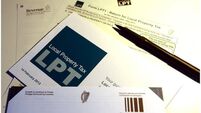Sorry Arnotts saga mirrors the rise and fall of the Celtic Tiger
There’s plenty else for sale at Arnotts too but let’s hope that the shop itself can be sold because the idea of the State owning and running this business is a sure sign of how wrecked our economy has become.
But that’s essentially the outcome of the news this week that two banks have taken control of the iconic Dublin retail department store. One of those banks is British-owned Ulster Bank but Anglo Irish Bank is already a shareholder in Arnotts and has the larger amount of loans owning to it for repayment. As the existing shareholders are going to be wiped out it is essentially Anglo — as the new majority owner — that will call the shots, albeit with advice and prodding from Ulster.
In other words, Arnotts has been nationalised by proxy.
The idea of Anglo — a failed bank — running a major retailer may seem bizarre but it has some sense. Firstly, Anglo has given the task to an American company, Paladin Capital, that has the relevant experience and expertise (albeit not in Ireland). Secondly, this measure defers and may even save Arnotts from suffering a worse fate.
My understanding of what has happened is that Taoiseach Brian Cowen become involved quietly in all of this earlier this year. The banks, knowing that Arnotts had a sizeable excess of liabilities over assets and fearing that the business had no way of generating enough money to make repayments of loans of over €260m, were on the verge of putting the company into receivership. In such circumstances the receiver would be required to run the business with the intention of raising as much cash as possible to pay off creditors, starting with the banks. However, the receiver would have been working under a legal obligation to reduce debts as quickly as possible, which could have led to major job losses and, eventually, the possible closure of the store if a new buyer could not be found.
Arnotts was days away from that but Cowen’s expression of interest in what was going on persuaded the banks to offer new financial terms to the company instead and new loan arrangements were put in place under onerous terms, including a future ownership change. Receivership would have done enormous damage to the reputation of the company and put it perilously near to being closed down, costing the 950 jobs at the store and damaging the chances of much of the loans (now mainly owed to the State) being repaid. But the consequences would have been even greater. While Henry Street in Dublin is the busiest shopping area in the State in terms of footfall it has struggled to compete with the higher spending areas of Grafton Street and the new shopping centre at Dundrum. Without Arnotts many of those who shop there would have been tempted to go elsewhere, doing damage to many of the other shops in the area, already struggling to pay high rents at a time of falling sales.
However, it is clear that ongoing normal business is not good at Arnotts either, even when you leave the cost of property speculation aside.
The Arnotts story is quite complicated in that for many years it functioned as a public company quoted on the stock market, with substantial shareholdings held by the Nesbitt and O’Connor families who had previously owned it in full for generations (raising money by selling shares to others via the stock market). But in 2003 there was an attempt by outside parties, who felt that the store was not fulfilling its potential to make profits, to buy Arnotts. The founding families responded by borrowing the money to buy the rest of the shares in the company themselves to “take it private”.
Having bought it for €267m they didn’t do the sensible thing of repaying the loans as quickly as possible. Instead barrister Richard Nesbitt — a highly self-confident man who was smitten by the idea of becoming a businessman and multi-millionaire — was bitten by the mania of the time: property development.
He put together a wildly ambitious plan to buy all of the land in the immediate area of the Arnotts store with the exception of the GPO. Arnotts bought the vast Independent Newspapers site — which included the old printing works and a listed facade — and dozens of other buildings with the intention of forming a gigantic site around Henry Street, O’Connell Street, Abbey Street and Liffey Street. His ambition was to redevelop the entire area to include apartment blocks, hotels and entertainment facilities along with shopping, a 16-storey tower block to be the centrepiece. The so-called Northern Quarter would cost over €750m to construct, all with borrowed money. Nesbitt brought in a venture capital partner Boundary Capital And it brought in Anglo Irish Bank as the financier, providing enormous loans.
By the time Nesbitt had acquired all of the land he needed it was too late to proceed with his massive venture. In that regard he was lucky but his good fortune was limited. He still had too much money borrowed and without the opportunity to sell apartments and hotels no way of making repayments. Criticism that the store had failed to move with modern trends had some justification but in trying to deal with this dilemma Arnotts suffered a massive fall in turnover. Having once enjoyed annual sales of about €200m per annum this fell last year to just €128m. Worse, the company made losses last year of €28m, the cost of shutting down an ill-fated temporary move of part of the operations up Henry Street to the Jervis Shopping Centre.
ARNOTTS has made much of the idea that it is trading as normal but nothing is normal at this enterprise any more. A viable business was wrecked by its becoming a speculative property company that forgot its roots in retailing. History or its name will not save it now.
So who do Anglo and Ulster Bank sell to and when? There may be few wealth Irish investors available to buy the company now, even at a knock down price, because banks would be reluctant to lend the funds to them. Even at a cheap price the fear for buyers is that the depth of our economic recession will dampen consumer spending patterns for many years to come.
It could be sold to a British or international department chain. The names of John Lewis and Debenhams and Selfridges, all fine companies, have been mentioned although none of these would be like to keep the 167-year-old Arnotts name. In any case would they see the Irish market as attractive now however? And wasn’t it incredible to learn this week that when Liam Maye died suddenly in mid-2008 his net worth was just €75,000 because of massive borrowings? This, after all, was the man who developed the Dundrum Shopping Centre and the Pavilion Shopping in Swords with O’Reilly and who left his family nothing despite having all the appearances of massive wealth. That is another story that has come to symbolise the extraordinary story of the rise and fall of the Celtic Tiger. But Arnotts — and the mistaken vision of Richard Nesbitt — is one that will take some beating. It is yet again something for which we will all settle the outstanding bills.
The Last Word with Matt Cooper is broadcast on 100-102 Today FM, Monday to Friday, 4.30pm to 7pm.














